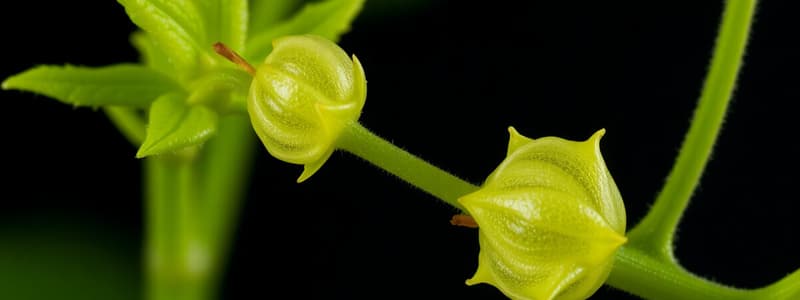Podcast
Questions and Answers
What is a primary advantage of asexual reproduction in plants?
What is a primary advantage of asexual reproduction in plants?
- Requires two parents for reproduction
- Provides resistance to habitat changes
- Produces genetically diverse offspring
- Allows rapid colonization (correct)
Which structure develops into the female gametophyte during the reproduction process?
Which structure develops into the female gametophyte during the reproduction process?
- Stem
- Anther
- Megaspores (correct)
- Ovary
What is the role of sepals in a flower?
What is the role of sepals in a flower?
- Contain the ovary
- Protect the flower bud (correct)
- Produce pollen
- Attract pollinators
What occurs during syngamy in the sexual life cycle of plants?
What occurs during syngamy in the sexual life cycle of plants?
Which of the following is NOT a component of complete flowers?
Which of the following is NOT a component of complete flowers?
How does cross-pollination differ from self-pollination?
How does cross-pollination differ from self-pollination?
What function do cotyledons serve in seed development?
What function do cotyledons serve in seed development?
What characterizes double fertilization in angiosperms?
What characterizes double fertilization in angiosperms?
Flashcards
Asexual Reproduction
Asexual Reproduction
Reproduction where offspring are identical to the parent.
Sexual Reproduction
Sexual Reproduction
Reproduction where offspring are genetically diverse.
Meiosis
Meiosis
Cell division producing haploid spores in flowers.
Pollen
Pollen
Signup and view all the flashcards
Complete Flower
Complete Flower
Signup and view all the flashcards
Pollination
Pollination
Signup and view all the flashcards
Cross-Pollination
Cross-Pollination
Signup and view all the flashcards
Fruit Layers
Fruit Layers
Signup and view all the flashcards
Study Notes
Asexual Reproduction
- Genetically identical offspring
- Favored in stable environments
- Enables rapid colonization
- Reproducible by isolated individuals
- Vulnerable to environmental changes
Sexual Reproduction
- Genetically diverse offspring
- Some offspring better adapted to new conditions
- Slower colonization
- Requires interaction of individuals
Reproduction Process: Meiosis
- Occurs in anthers and ovules
- Creates haploid microspores and megaspores
- Microspores form male gametophytes (pollen)
- Megaspores form female gametophytes (embryo sac)
Pollen
- Male gametophyte
- Forms pollen tubes with two sperm nuclei
Female Gametophyte
- In the ovule
- Contains egg, antipodals, synergids, and polar nuclei
Asexual Reproduction: Fragmentation
- Common method
- Plant parts develop into independent individuals
Sexual Life Cycle of Plants
- Sporophytes: Diploid, produce haploid spores
- Gametophytes: Produce gametes via mitosis, undergo syngamy to form zygote
Flower Structure: Complete Flowers
- Contain sepals, petals, stamens, and carpels
Flower Structure: Sepals
- Protect the developing flower bud
Flower Structure: Petals
- Attract pollinators
Flower Structure: Stamens
- Produce pollen
Flower Structure: Carpels
- Include ovary, style, and stigma
Pollination and Fertilization
- Pollination: Transfer of pollen to stigma
- Fertilization: Fusion of sperm and egg (Double fertilization in angiosperms)
Embryo and Seed Development
- Zygote forms the embryo
- Cotyledons store nutrients
- Seed coat develops from integuments
Fruit Development
- Ovary develops into fruit
- Fruit has layers: exocarp (outer), mesocarp (middle), endocarp (inner)
Cross-Pollination vs. Self-Pollination
- Cross-pollination: Pollen from a different individual
- Self-pollination: Pollen from the same flower or plant
Pollination Mechanisms
- Animal pollination: Co-evolution with animals
- Wind pollination: Lack of petals, large stigma, many pollen grains
Fruit Types and Seed Dispersal
- True fruits: Contain only ovarian tissue
- Accessory fruits: Include non-ovarian tissue
- Seed dispersal: By wind, water, or animals
Studying That Suits You
Use AI to generate personalized quizzes and flashcards to suit your learning preferences.




